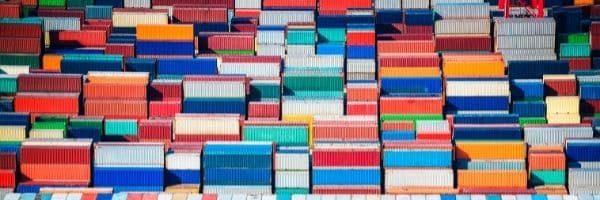From ship to shelf, supply chain challenges continue going into the holiday season. In October, a record number of container ships waited to berth and unload. Labor shortages, COVID disruptions and holiday peak season shipping continue to push supply chain shipping to its limits. Freight congestion will continue into 2022.
The most recent data shows, U.S. imports from Asia continue at record or near-record volumes and have for an unprecedented 12 consecutive months. Imports from Asia in the first six months of 2021 were up 38 percent from the first half of 2020, according to PIERS, a JOC.com sister company within IHS Markit.
Port officials in LA/Long Beach are calling on the import community to pick up the pace on unloading and moving containers from the port to create space for the surge of imports, yet with persistent bottlenecks in each phase of the shipping supply chain it makes the plea near impossible. The dozens of ships waiting on the water to port in Southern California are just the first shipment bottleneck.
Steamships and air freight
In Asia, manufacturing is still behind and as companies work to catch up on orders, it is creating record shipping demand. This is impacting import congestion, driving up cost and creating delivery issues for a variety of reasons.
- In July, Asia-North Europe on-time performance fell to 22.2% compared to 90% in July 2020, according to the latest data from Sea- Intelligence Maritime Analysis.
- Alphaliner said in its latest weekly newsletter that the members of the three main alliances — 2M, Ocean Alliance, and THE Alliance — control 99.5 % of all capacity on the Asia-Europe trade.
While the cost of air freight cooled a bit in the early summer, prices are rising due to cancelled flights and high demand. Companies that can bring goods into the United States via air are discovering getting goods that have just landed is yet another issue in the supply chain. There aren’t enough people working to keep shipments moving from the airplane onto the next mode of transportation that requires drivers and equipment, currently in short supply.
Rail challenges
Bottom line, Chicago is a bottleneck in the global supply chain.
The city’s railyards are strained because seven of the major North American freight railroads converge, creating a complicated web of operations in which inbound and outbound shipments are traded off between trains and trucks. It is also located within a 500-mile truck journey of about one-third of the U.S. population, making it a prime distribution hub.
In July, Union Pacific officials said the company temporarily reopened a former intermodal facility in the Chicago area to alleviate congestion. Chief Executive Lance Fritz said shippers are struggling to take boxes quickly enough from the railroad’s ramps to warehouses and distribution centers.
Trucking issues
Some third-party logistics firms say customers are diverting rail orders to St. Louis and Kansas City, Mo., or to Memphis, Tenn. Still when shipments arrive, trucking becomes the next bottleneck, whether at the port or from a railyard.
This is the fourth straight year there’s been a driver shortage. Drivers cite concerns that range from safe truck parking to wages to detention and demurrage. Carriers concerns are the shortage of drivers and retaining those who are driving. Still DAT.com reports truckload rates are steady. The issue is too many containers to move and not enough people or equipment to do it.
Cass Information Systems manages data in the freight industry. The company released a Transportation Index Report for July showing shipments grew 15.6% year over year in July. This was lower than the June increase of 26.8%. The report says driver and equipment shortages are the reason behind slowing shipment volumes.
Warehouse space
United States retailers and manufacturers in search of additional warehouse space in major seaport and inland hubs are out of luck as distribution centers are quickly filling to capacity with peak-season imports already flooding into the country.
Projections for 2021… no relief in sight
According to the Global Port Tracker, which is published monthly by the National Retail Federation and Hackett Associates, when July’s import numbers are available, they will show an increase of 15.7 percent from July 2020, which marked the beginning of the post-COVID-19 reopenings in the US last year.
Global Port Tracker projects that August imports will increase 12.6% from August 2020, while September will be up 4.9% year over year. Although it projects October will be down 3% year over year, Global Port Tracker has raised its forecast from the projections made the previous month in each report since spring.
What does this mean for your supply chain? Relief is not in sight yet. Expect continued record high costs and historic delays well into 2022 as the world continues to experience freight congestion in unprecedented times.
Cargo Services team of trusted and tenured professionals continues to support customers supply chain needs
and is working with new customers. Contact us.

